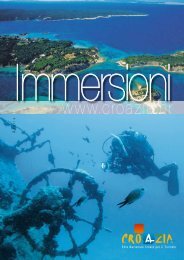Diving
Diving
Diving
Create successful ePaper yourself
Turn your PDF publications into a flip-book with our unique Google optimized e-Paper software.
The Adriatic Sea has for ages been the closest maritime route from the central<br />
Mediterranean and the seats of the great civilisations of the antiquity to the northern<br />
regions and the central European mainland. As an important route its shores bear the<br />
indelible traces of all periods of the development of global and European civilisation,<br />
both on land and beneath its blue surface. Astronauts have seen that the seas of the<br />
Croatian Adriatic<br />
General data and characteristics<br />
world truly have the colour their name imparts them: the Red Sea is truly red, the Black<br />
Sea black and the Adriatic Sea – a true blue sea. By its configuration and its level of<br />
indentation the Croatian shores of the Adriatic Sea bring together all of the geological<br />
diversity of the Mediterranean, it has for thousands of years been the crossroads of all<br />
routes linking the European and Asian regions (the Near East), it is home to the oldest<br />
traces of the formation of western civilisation, and, climatically protected by the Alps, it<br />
preserves a warm Mediterranean clime deep into the north of the European mainland.<br />
The Croatian shores of the Adriatic are for this reason considered a unique example of<br />
the integration of the wealth of the Mediterranean, not only by its history, but also by its<br />
natural beauty.<br />
The Adriatic Sea (Mar Adriatico, Adria) is an<br />
integral part of the Mediterranean characteristic<br />
for its deep reach into the land mass of Europe,<br />
between the extensive coastlines of Italy and<br />
Croatia, and as such is its section closest and<br />
most accessible to Central Europe. Its eastern<br />
shores, the Croatia Adriatic, is its most intricately<br />
indented part, with a total of 1185 islands,<br />
islets and reefs, with a total coastline length<br />
of 5,835 km, a surface area of 138,595 km 2<br />
and its greatest depth being 1330 m (Southern<br />
Adriatic Depression) and with waters that are<br />
exceptionally transparent to a depth of 50 m.<br />
Sea temperature fluctuations throughout the<br />
year: in winter months temperature ranges from<br />
7 to 10 o C, in summer months average surface<br />
temperature is from 21 to 26 o C, while the<br />
temperature at a depth of from 20 to 30 m<br />
(average diving depth) remains constant<br />
throughout the year, ranging from 16 to 17 o C.<br />
Salinity is 38.32 per mille; the difference<br />
between high and low tide varies from 40 cm<br />
(Southern Adriatic and Dalmatia) to 1 m at Istria.<br />
The Adriatic is a relatively calm sea, with no high<br />
waves or strong currents. Wave height ranges<br />
from 40 to 150 cm, to 4 to 5 m at the most in<br />
extremely adverse weather conditions on the<br />
open sea. Speed of sea currents is about 0.5<br />
knots, although in certain places and in special<br />
weather conditions it can reach up to 4 knots.<br />
Croatian National Tourist Board<br />
1




